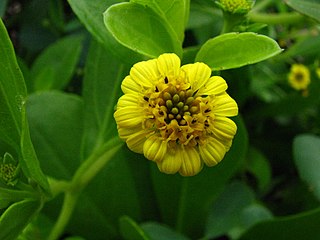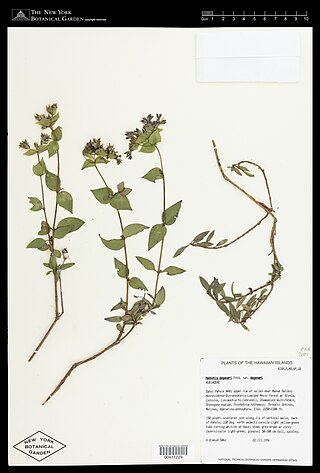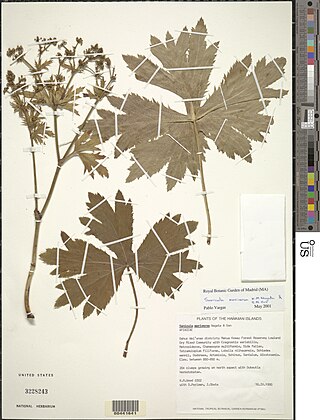
Kaʻena or Kaena Point is the westernmost tip of the island of Oʻahu. In Hawaiian, kaʻena means "the heat". The area was named after a brother or cousin of Pele. The point is designated as a Natural Area Reserve.
Hawaiian hibiscus are seven species of hibiscus native to Hawaii. The yellow hibiscus is Hawaii's state flower. Most commonly grown as ornamental plants in the Hawaiian Islands are the non-native Chinese hibiscus and its numerous hybrids, though the native Hibiscus arnottianus is occasionally planted.

Lipochaeta succulenta, the seaside nehe, is a plant endemic to all the main Hawaiian islands except Lanai.
Geniostoma cyrtandrae, the Koʻolau Range labordia, is a species of flowering plant in the Loganiaceae family. It is endemic to lowland tropical moist forests in Hawaiʻi, and is threatened by habitat loss. Like other labordias, this plant is known as Kamakahala.

Lipochaeta, common name nehe, is a genus of flowering plants in the family Asteraceae that is endemic to Hawaii.

Melanthera, is a genus of perennial flowering plants in the family Asteraceae, native to North and South America, as well as Africa, Asia and Oceania, including Hawaiʻi.
Cyanea longiflora is a rare species of flowering plant in the bellflower family known by the common name ridge rollandia. It is endemic to Oahu where there are only three remaining occurrences in the northern Waianae Mountains for a total of under 300 individuals. It is a federally listed endangered species. Like other Cyanea it is known as haha in Hawaiian.

Kadua coriacea is a rare species of flowering plant in the coffee family known by the common name kioʻele. It is endemic to Hawaii, where it is known only from the island of Hawaiʻi and one individual remaining on Maui. It is a federally listed endangered species of the United States.

Kadua degeneri is a rare species of flowering plant in the coffee family known by the common names Waianae Range starviolet and Degener's bluet. It is endemic to Hawaii, where it is known only from the island of Oahu. There are four known populations totalling 370 individuals. It is a federally listed endangered species of the United States.
Lepidium arbuscula is a rare species of flowering plant in the mustard family known by the common names `anaunau and Waianae Range pepperwort. It is endemic to Hawaii, where it is known only from the Waianae Mountains on the island of Oahu. In 2003 there were ten populations remaining with fewer than 1000 individuals in total. It is a federally listed endangered species of the US.

Melanthera fauriei, known by the common name Olokele Canyon nehe, is a rare species of flowering plant in the aster family.
Melanthera kamolensis, known by the common name Maui nehe, is a rare species of flowering plant in the family Asteraceae.

Lipochaeta lobata is a species of flowering plant in the family Asteraceae known by the common name shrubland nehe. It is endemic to Hawaii, where it can be found in coastal dry shrublands and dry forests on Oʻahu, Maui, and Niʻihau.

Melanthera micrantha, known by the common name Kauai nehe, is a rare species of flowering plant in the family Asteraceae.
Melanthera venosa is a rare species of flowering plant in the family Asteraceae known by the common name spreading nehe. It is endemic to Hawaii, where it is known only from the island of Hawaii. It is federally listed as an endangered species of the United States.
Melanthera waimeaensis is a rare species of flowering plant in the family Asteraceae known by the common name Waimea Canyon nehe. It is endemic to Hawaii, where it is known only from the island of Kauai. It is federally listed as an endangered species of the United States.

Lobelia oahuensis is a rare species of flowering plant in the bellflower family known by the common name Oahu lobelia. It is endemic to Hawaii, where it is known only from the island of Oahu. There are about 100 individuals remaining in the Koʻolau Range, and only one known individual in the Waianae Range. It is federally listed as an endangered species of the United States.

Sanicula mariversa is a rare species of flowering plant in the family Apiaceae known by the common name Waianae Range black-snakeroot. It is endemic to Hawaii, where it is known only from the Waianae Mountains on the island of Oahu. It is threatened by the degradation of its habitat. It is a federally listed endangered species of the United States.
Schiedea kealiae is a rare species of flowering plant in the family Caryophyllaceae known by the common name Waianae Range schiedea. It is endemic to Hawaii, where it is known only from the Waianae Range on the island of Oahu. It is threatened by the degradation and destruction of its habitat. It was federally listed as an endangered species of the United States in 1996.

Tetramolopium lepidotum is a rare species of flowering plant in the family Asteraceae known by the common name Waianae Range tetramolopium. It is endemic to Hawaii, where today it is known only from the Waianae Mountains on the island of Oahu. It is threatened by habitat degradation caused by feral goats and pigs and introduced species of plants.













